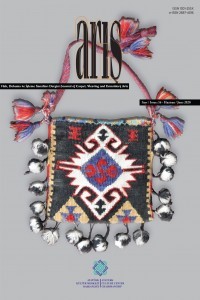
Arış Dergisi
Yazarlar: Fatma Yelda GEZİCİOĞLU, Günay ATALAYER
Konular:Sanat
DOI:10.34242/akmbaris.2020.144
Anahtar Kelimeler:Weaving,Çekmeli Weaving,Weft Loop,Egypt,Copt Fabrics,Pattern
Özet: When considered from the historical development process, it can be seen that weaving is one of the most ancient production methods and branches of handicraft. Weaving had been an indicator of cultural development of communities and formation of creative thinking through material, in other words, a tool for humans to express one self. It is observed that weaving was developed in line with the needs of humanity; functionality had changed and diversified in line with the patterns and technical quests and transformed into artistic production. In some historical examples of the weavings in Egypt it is seen that a weaving technique is used where the 2nd weft thread (extra weft/weft for pattern) is pulled up in a way to form a patterned fabric surface with loops. It is observed that a variety of colours and patterns may be formed on woven fabrics by creating the images of loop/uncut pile and coiled yarn on woven fabrics through the use of loops (made by applying the çekmeli/weft loop/uncut pile technique.) The term “Çekmeli” is one of those popular names of this technique used in Anatolia. Its use in this article is deemed proper as the action related to this term reflects a correct description in Turkish. The aim is to bring the term “Çekmeli” into the textile terminology as a Turkish word among with many other descriptions of it in other languages. In this study similar patterns of the single layer and patterned historical woven fabrics made in Egypt ( the loop image is created by pulling the weft thread up to the surface and as such these loops create patterns on the surface, and thus become an aesthetic element) but exhibited in the museums around the world have been selected and studied. The examples similar to the “çekme technique” (loop/uncut pile) are focused and they are studied as far as their weaving structures are concerned. The authors of this article are concentrated on a comprehensive research on “çekmeli weavings” especially in the Central Anatolia.
Dergi editörleri editör girişini kullanarak sisteme giriş yapabilirler. Editör girişi için tıklayınız.